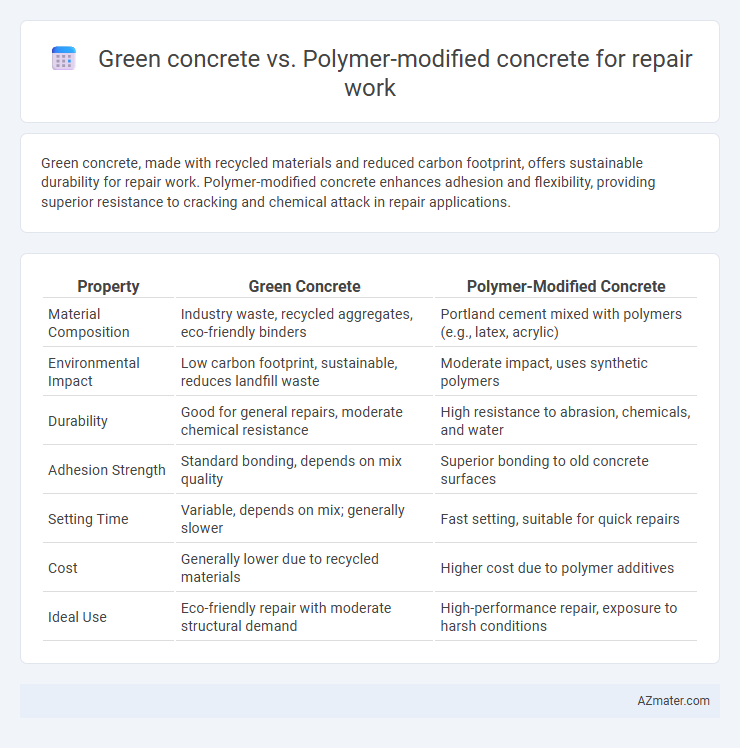Green concrete, made with recycled materials and reduced carbon footprint, offers sustainable durability for repair work. Polymer-modified concrete enhances adhesion and flexibility, providing superior resistance to cracking and chemical attack in repair applications.
Table of Comparison
| Property | Green Concrete | Polymer-Modified Concrete |
|---|---|---|
| Material Composition | Industry waste, recycled aggregates, eco-friendly binders | Portland cement mixed with polymers (e.g., latex, acrylic) |
| Environmental Impact | Low carbon footprint, sustainable, reduces landfill waste | Moderate impact, uses synthetic polymers |
| Durability | Good for general repairs, moderate chemical resistance | High resistance to abrasion, chemicals, and water |
| Adhesion Strength | Standard bonding, depends on mix quality | Superior bonding to old concrete surfaces |
| Setting Time | Variable, depends on mix; generally slower | Fast setting, suitable for quick repairs |
| Cost | Generally lower due to recycled materials | Higher cost due to polymer additives |
| Ideal Use | Eco-friendly repair with moderate structural demand | High-performance repair, exposure to harsh conditions |
Introduction to Concrete Repair Materials
Green concrete and polymer-modified concrete represent advanced materials in concrete repair, designed to enhance durability and sustainability. Green concrete utilizes industrial by-products such as fly ash and slag to reduce carbon footprint while maintaining structural integrity. Polymer-modified concrete incorporates synthetic resins to improve adhesion, flexibility, and resistance to chemicals, making it ideal for repairing damaged or deteriorated concrete surfaces.
What is Green Concrete?
Green concrete is an eco-friendly construction material made by incorporating recycled industrial waste, such as fly ash, slag, or silica fume, reducing the consumption of traditional cement and thereby lowering carbon emissions. It enhances sustainability by utilizing renewable resources and improving energy efficiency in the production process. Green concrete offers comparable strength and durability to conventional concrete, making it a viable option for repair work with minimal environmental impact.
Understanding Polymer-Modified Concrete
Polymer-modified concrete (PMC) enhances traditional concrete by incorporating polymers such as styrene-butadiene or acrylics, which improve adhesion, flexibility, and durability essential for repair applications. Compared to green concrete, which prioritizes sustainability through recycled materials and reduced carbon footprint, PMC offers superior resistance to cracking, chemical exposure, and water penetration, making it ideal for structural repairs in challenging environments. Understanding the polymer types and their compatibility with existing substrates is critical for maximizing the performance and longevity of repairs using polymer-modified concrete.
Composition and Material Differences
Green concrete incorporates supplementary cementitious materials such as fly ash, slag, or silica fume to reduce cement content and carbon footprint, enhancing sustainability and durability. Polymer-modified concrete integrates synthetic polymers like latex or epoxy, which improve adhesion, flexibility, and resistance to chemicals and water ingress. The fundamental material difference lies in green concrete's eco-friendly binders versus polymer-modified concrete's elastomeric and adhesive polymers designed to enhance repair performance.
Environmental Impact: Green Concrete vs Polymer-Modified Concrete
Green concrete utilizes industrial by-products like fly ash and slag, significantly reducing carbon emissions and conserving natural resources compared to traditional concrete, making it an eco-friendly option for repair work. Polymer-modified concrete incorporates synthetic polymers that enhance durability and adhesion but involve petroleum-based materials, leading to a higher environmental footprint during production and disposal. Evaluating repair projects for sustainability, green concrete offers a greener lifecycle with reduced greenhouse gas emissions and resource consumption, whereas polymer-modified concrete prioritizes performance with a relatively greater environmental impact.
Strength and Durability Comparison
Green concrete, incorporating recycled materials and supplementary cementitious substances, offers substantial compressive strength with enhanced environmental benefits, but may exhibit variable early-age strength compared to polymer-modified concrete. Polymer-modified concrete significantly improves tensile strength, adhesion, and flexural durability due to the polymer matrix, making it highly resistant to cracking and chemical attacks in repair applications. The durability of polymer-modified concrete under aggressive environmental conditions generally surpasses green concrete, although the latter excels in sustainability and long-term stability for structural repair projects.
Application and Workability in Repair Projects
Green concrete offers enhanced sustainability and excellent environmental benefits, making it suitable for repair projects prioritizing eco-friendly materials, with moderate workability for surface restoration and patch repairs. Polymer-modified concrete provides superior adhesion, flexibility, and chemical resistance, ensuring durable and resilient repairs in structures exposed to dynamic loads or harsh environments, with improved workability that facilitates easy application and bonding on various substrates. Both materials serve distinct repair needs, where green concrete excels in sustainable patching and polymer-modified concrete delivers robust performance in demanding structural repairs.
Cost Analysis: Initial and Long-Term
Green concrete generally incurs higher initial costs due to the use of sustainable materials like recycled aggregates and industrial by-products, but its durability and reduced environmental impact can lead to lower long-term expenses in repair work. Polymer-modified concrete tends to have a moderate to high initial investment, driven by specialized polymers enhancing adhesion and flexibility, which often results in extended service life and fewer maintenance interventions. Cost analysis favors green concrete for projects prioritizing environmental sustainability and long-term savings, while polymer-modified concrete may be preferred for applications requiring rapid curing and superior mechanical properties.
Suitability for Different Types of Repairs
Green concrete offers excellent environmental benefits and is suitable for general structural repairs where sustainability is a priority, particularly in non-rapid setting applications. Polymer-modified concrete excels in repairs requiring enhanced durability, chemical resistance, and adhesion, making it ideal for high-traffic areas, infrastructure exposed to aggressive conditions, or locations needing rapid strength gain. Choosing the appropriate material depends on the repair's exposure conditions, load requirements, and desired curing time to ensure long-lasting performance.
Future Trends in Sustainable Concrete Repair Solutions
Green concrete incorporates eco-friendly materials like fly ash and slag to reduce carbon footprint, while polymer-modified concrete enhances durability and adhesion in repair work through synthetic resins. Future trends in sustainable concrete repair focus on combining these technologies to create hybrid solutions that improve performance and environmental impact. Advances in nanotechnology and bio-based polymers are expected to drive innovation, enabling longer-lasting repairs with reduced ecological damage.

Infographic: Green concrete vs Polymer-modified concrete for Repair work
 azmater.com
azmater.com